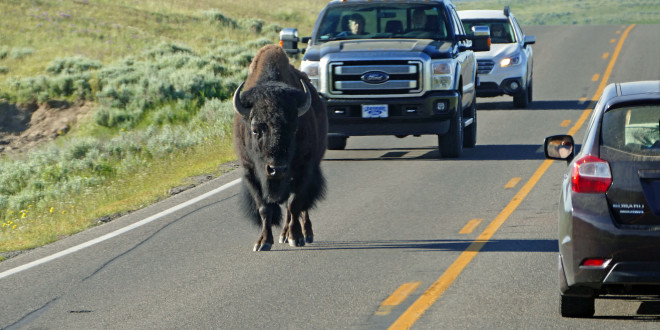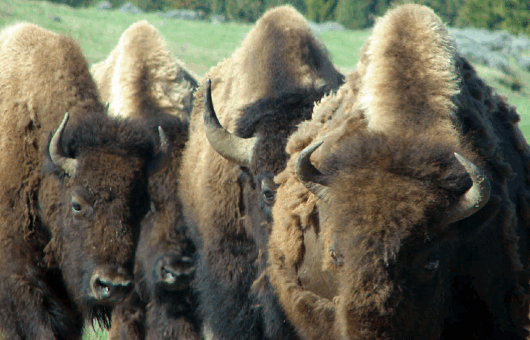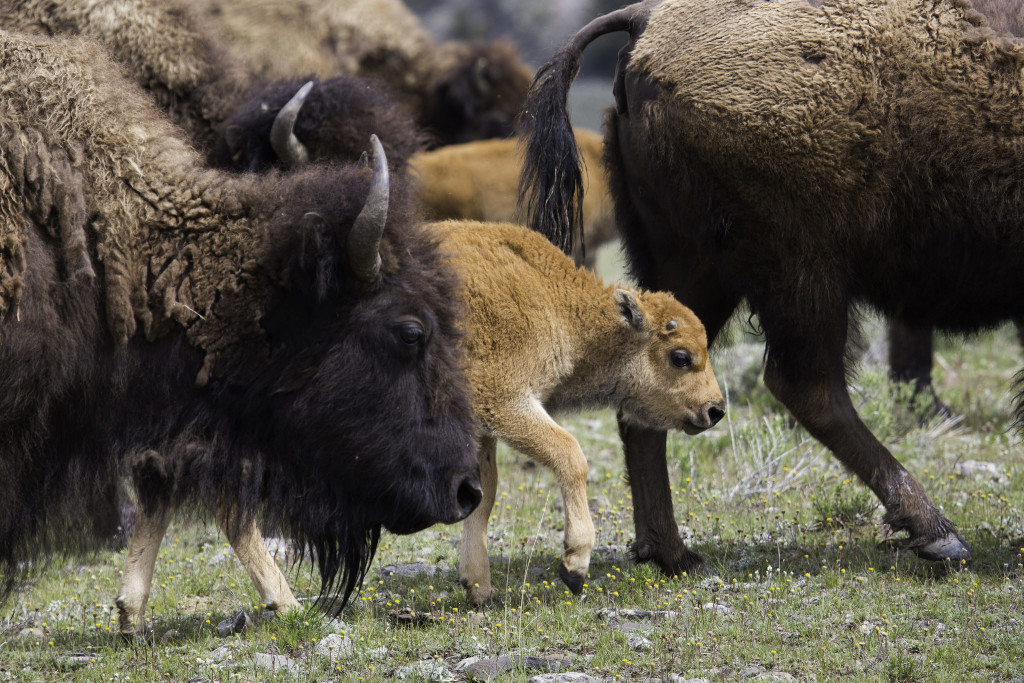Breaking news, folks: Montana Governor Steve Bullock will allow bison to roam between Yellowstone National Park and Montana year-round.
In a move that will undoubtedly have some jubilant and some derisive, Bullock is pursuing an adaptive management adjustment under the Interagency Bison Management Plan to allow Yellowstone bison to roam between the Yellowstone and Montana border and occupy “suitable habitat,” a decision driven by input from IBMP stakeholders and firsthand observation of the Yellowstone bison population.
Bison (you will recall) historically migrated out of the Park to seek lower elevation grazing land in winter, which Yellowstone cannot always provide. And historically, they’ve been hazed back into the Park, both for their own protection as well as out of concern for brucellosis, a debilitating cattle disease that prompts abortions in cows and can cost ranchers and livestock officials dearly with quarantine and slaughter fees.
This decision is nothing short of monumental, given the previous management regime which sought to haze bison back into the Park. Indeed, it’s kind of a big deal for it to be happening this year into next, especially after Park officials announced their intention to cull 1,000 bison this year under the IBMP. And while this quota was eventually dropped, it wasn’t certain what path bison management would take, this year and beyond.
What Would Year-Round Bison Look Like And Why?
That path, it appears, is one of compromise: letting bison roam while stipulating that they be managed as rigorously as years past. So don’t go shouting “Home on the Range” all the way to Kalispell quite yet.
“An adaptive approach to bison management means we look at how we are doing things, assess our effectiveness, and adapt accordingly,” said Bullock in a press release. “This decision is a very modest expansion of the conditions under which bison may remain outside of the Park, in response to changing science and changing circumstances on the ground. While at the same time I am confident our livestock industry is protected. Further, I remain committed to continuing to pressure the Park Service to reduce the bison population in the Park, and keep those numbers to manageable levels. ”
The crux of this decision is bison will be allowed to roam in “tolerance areas” outside the Park, detailed in an environmental assessment drafted by the Montana Fish, Wildlife & Parks agency and signed by Bullock. All bison will be allowed in portions of Montana directly west of the Park (Horse Butte, along U.S. Highway 191 up to the Taylor Fork Drainage). Bull bison will be permitted to roam north from the Gardiner Basin to the southern outlet of Yankee Jim Canyon. Outside said tolerance areas, bison will be subject to the older practice of hazing them back. Otherwise, if hazing proves ineffectual, they will be subject to trapping or removal via slaughter or hunting.
The EA also outlined several changes observed since the IBMP was established in 2000, which (by necessity) alter how officials will manage bison outside the Park:
• Cattle are no longer found on Horse Butte because of change in ownership and subsequent changes in land use.
• Several Forest Service grazing allotments have been closed, including those at Horse Butte and in the Taylor Fork drainage. For remaining allotments in the larger area, the Forest Service has adopted an adaptive approach to minimize risk of brucellosis transmission.
• Modifications in the federal rules that govern the response to brucellosis infection in cattle.
• Research on brucellosis persistence indicating decreased risk related to cattle turnout dates in the Hebgen Basin.
• Recognition of the role of elk as the primary transmission route of brucellosis transmission to livestock.
In essence, this new management regime will look much like the old regime, albeit with more space for bison to roam and new information dictating management protocol.
“A big step forward for wild bison in Montana”
In the aftermath of Bullock’s announcement, the Natural Resources Defense Council issued a statement from Matt Skoglund, Director of the Northern Rockies Office of the NRDC, in response to the proposed changes:
Giving wild bison from Yellowstone year-round habitat in Montana is a welcome holiday offering from Governor Bullock. While I’d certainly love to see the state go further, this decision is a big step forward for wild bison in Montana, and it will show that wild bison and people can successfully share the Montana landscape outside Yellowstone National Park. When you consider this from a science, economics, public opinion, or common sense perspective, it makes sense for Montana to give wild bison from Yellowstone year-round habitat in the state.
Why The Decision Is Important
This decision represents a paradigm shift for IBMP stakeholders, and could very well open additional avenues for bison restoration outside of Montana. Although Yellowstone bison cannot be transported outside the Park and established elsewhere due to their status as brucellosis vectors, there are possible workarounds. Indeed, a herd established in northern Colorado are direct descendants of the Yellowstone bison, only brucellosis-free due to a process developed by Colorado State University.
In the meantime, allowing bison into portions of Montana will offer IBMP partners and observers opportunities to learn how bison management should be handled in the 21st century. Possibly beyond. Who knows?
Regardless of where you stand on the issue, whether you want bison returned to their historic ranges or want them confined even further, you have to admit: this is a remarkable about face from the past century. Remember: bison were nearly extirpated from North America, were almost driven to extinction. The fact that Yellowstone bison are at the point where their numbers are high enough to permit letting them roam outside federal land (to say nothing of the droves of domesticated bison scattered across the U.S.) is nothing short of a miracle. Really.
 Yellowstone Insider Your Complete Guide to America's First National Park
Yellowstone Insider Your Complete Guide to America's First National Park








You must be logged in to post a comment.